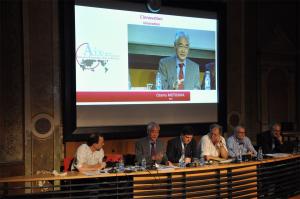At International Forum, fusion rhymes with innovation
13 Jul 2012
-
Robert Arnoux
The ITER Project, which Director-General Motojima presented as "innovation itself," was the focus of strong interest last weekend at the Rencontres Economiques in Aix-en-Provence.
One Prime Minister (Italy's Mario Monti); one former French President (Valéry Giscard d'Estaing); a US Supreme Court Justice (Stephen Breyer); a European Commissioner (Michel Barnier); several World Bank executives; high-profile university professors; a number of international CEOs; the Director-General of ITER ... all were gathered in Aix-en-Provence last weekend to participate in the Rencontres Économiques, an international forum aiming to promote a better understanding of global economic challenges and "to reflect on the actions that will influence the future of human society."
One of the main themes discussed this year: Innovation. What creates favourable conditions for innovation? Which innovations are most likely to succeed? Can society impulse innovation? The ITER Project, which Director-General Osamu Motojima presented as "innovation itself," was quite naturally the focus of strong interest from the participants.
As explained in the documentation distributed to the audience, fusion research in general and ITER in particular have been a major booster for innovation. The complexity of the ITER design has already pushed a whole range of leading-edge technologies to new limits. Time and again, innovative technological solutions have been developed to address specific ITER challenges, solutions that have found applications well beyond the bounds of fusion technology.
There are already numerous examples of fusion spin-offs that are providing concrete solutions to real and current problems.
Already, superconductor R&D has led to significant spin-offs in magnetic resonance imaging; diagnostics developed for the study of plasma turbulence have found applications in advanced satellite thrusters; innovative techniques to bond carbon-fibre composites originally developed for tokamaks are now used in aerospace... even the clothing industry has benefitted from fusion spin-offs: the electronic looms that produce high added-value cloth and fabrics from computer-generated design owe much of their performance and reliability to the very micro-actuators that were developed for tokamak components.
Already, superconductor R&D has led to significant spin-offs in magnetic resonance imaging; diagnostics developed for the study of plasma turbulence have found applications in advanced satellite thrusters; innovative techniques to bond carbon-fibre composites originally developed for tokamaks are now used in aerospace... even the clothing industry has benefitted from fusion spin-offs: the electronic looms that produce high added-value cloth and fabrics from computer-generated design owe much of their performance and reliability to the very micro-actuators that were developed for tokamak components.
One of the most valuable innovations of ITER however, does not belong to the realm of science or technology. The collaboration between 34 nations in pursuit of one goal, Director-General Motojima stressed, "is creating a new culture standard." The ITER project is a strong testimony to human creativity and resourcefulness; it demonstrates daily that nations—when confronted with a global challenge—can pull together to establish a completely new model for international cooperation.
See more information about fusion spinoffs here.


